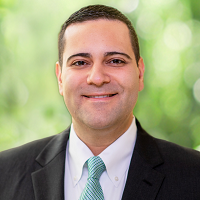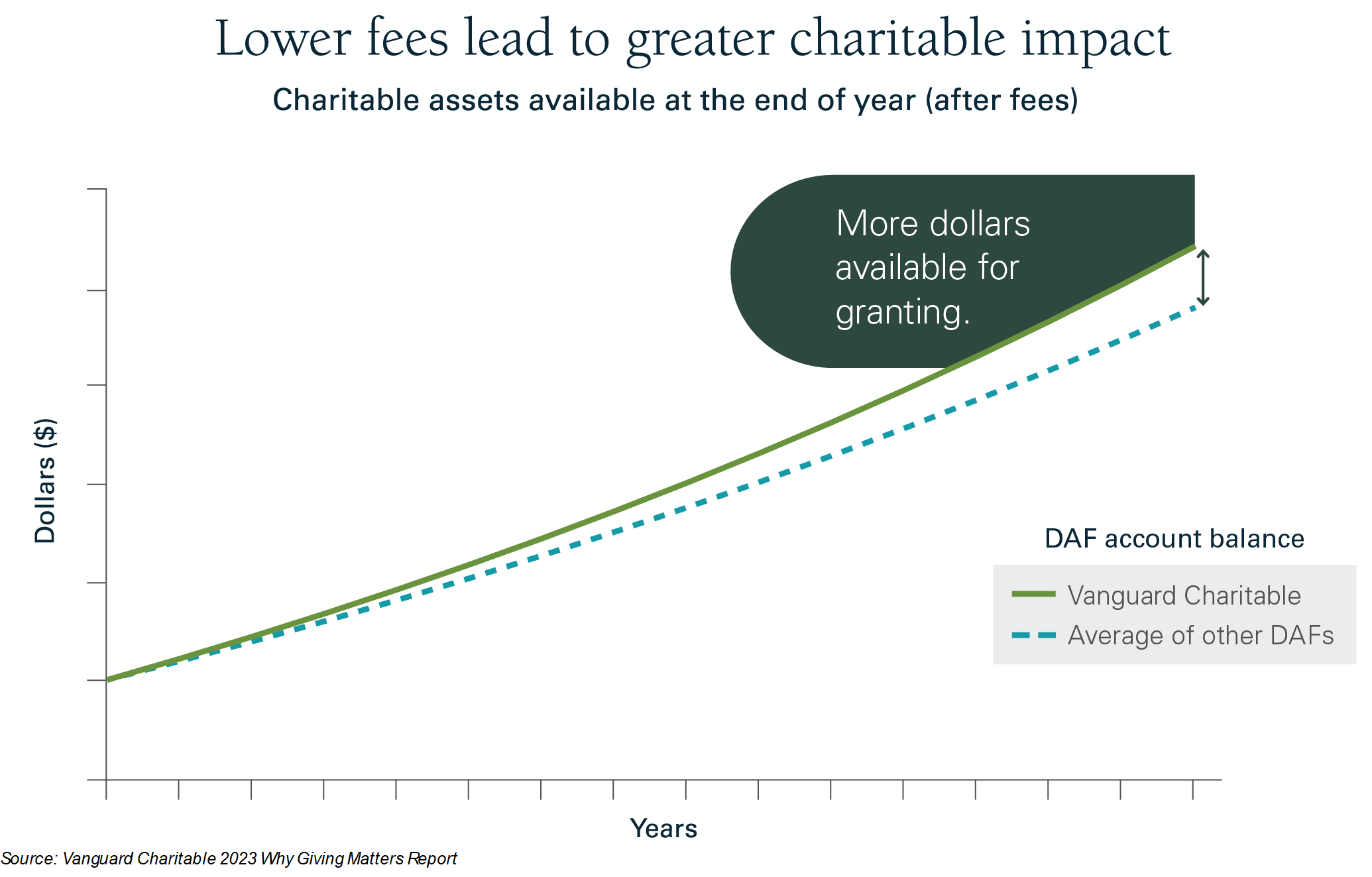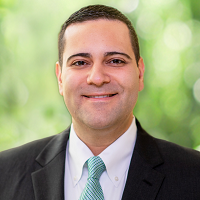The Secret to Supercharging Your Charitable Giving: Low Fees
What are you paying in investment and administrative fees? The less you pay, the more your money grows, and so does the impact your giving makes.


Charitable giving vehicles can be powerful tools in maximizing philanthropic impact. Private foundations, charitable trusts and donor-advised funds (DAFs) all allow donors to invest charitable assets for growth, expand the assets they can give to charity, and help with due diligence around selecting causes and organizations to support. This kind of strategic support requires oversight and administration — both of which carry a cost.
Many factors influence your ability to earn a return. That’s true across all kinds of investing, including charitable investing, where "return" equates to "charitable impact" for the causes philanthropically minded investors care about. While we can't control markets or the economy, we can control the costs we pay in managing or allocating our charitable dollars.
Ultimately, investment data is clear: The expense ratio is the most proven predictor of future fund returns. Money paid in fees ultimately comes out of the sum of assets, which means there is less to invest, grow and use for grantmaking.
From just $107.88 $24.99 for Kiplinger Personal Finance
Become a smarter, better informed investor. Subscribe from just $107.88 $24.99, plus get up to 4 Special Issues

Sign up for Kiplinger’s Free Newsletters
Profit and prosper with the best of expert advice on investing, taxes, retirement, personal finance and more - straight to your e-mail.
Profit and prosper with the best of expert advice - straight to your e-mail.
Understanding the nature of fees and costs and their impact on an individual’s ability to give is an essential component of an effective charitable giving strategy. That strategy starts with a deeper dive into the fees and how they differ across giving vehicles. When evaluating costs and fees in philanthropic giving, particularly in the context of private foundations and donor-advised funds (DAFs), here are a few key points to keep in mind.
Most charitable giving costs fall into two categories
Most of the costs associated with investing — whether it be for charitable giving, retirement or other purposes — come from one of two sources: investment fees and administrative fees.
Investment fees cover the costs of managing invested assets. Different asset classes will have different fees and overall costs, and different investment vehicles and advisers will as well.
Administrative fees cover general operating costs, including legal, accounting, processing and staffing expenses. These administrative fees can also vary greatly depending on the organization or individual overseeing the philanthropic strategy. Costs related to operations, and tools such as investor services, investment portals and research, may be included under administrative fees.
Different approaches come with different costs
The complexity and focus of the charitable investment vehicle can be a driving force in cost structure and overall fees. A private foundation can include services and approaches highly tailored to a family or donor’s specific needs. Naturally, those high-touch services can increase administrative fees. At the same time, advisers and other oversight or guidance can also drive up investment fees.
DAFs, a giving vehicle that can support a wide array of causes through grants to qualified 501(c)(3) charities, tend to prioritize a low-cost, high-impact approach to philanthropy. DAFs benefit from economies of scale around operations and grantmaking, with annual administrative fees among national DAF sponsors typically falling around 0.6%, and investment fees ranging from 0.015% to 0.99%. Community foundations may charge more for DAFs but may also offer useful philanthropic and granting guidance relevant to the communities they serve.
Certain DAF sponsors, including Vanguard Charitable, utilize additional levers to maintain low costs. These can include curating a smaller number of high-performing investment options, as well as giving donors access to low-cost share classes typically unavailable to the public.
There’s also a broader philosophical perspective around fees and costs worth exploring across giving vehicles. Some organizations align their entire approach around keeping costs low. At Vanguard Charitable, for instance, recent reductions in the expense ratios for several of its 35 investment options will lead to annual savings of more than $1 million, which will be granted by Vanguard Charitable donors to hardworking charities across the country and the world.
Savings — and tax benefits — compound over time

Investors like to call compound growth “the eighth wonder of the world.” And for good reason. Just like saving for retirement or any other investment approach, the positive effect of lower fees has a greater impact over time. These compound benefits play out on a few key fronts. Lower investment and administrative fees mean a greater portion of assets can be directed toward charitable investments. This, in turn, means more dollars are available to grant to nonprofits, deliver on a philanthropic strategy, and make an impact on meaningful cause areas.
The compound benefits extend to tax savings, too. The upfront tax savings for charitable contributions means more dollars are available to potentially grow and grant out over time. At the same time, the tax-free earnings for assets in an account compound over time, again allowing more money to be directed toward charitable giving. These tax savings can be achieved with both DAFs and private foundations, although private foundations are subject to a separate excise tax on net investment income, whereas DAFs are not.
Meaningful conversations around costs and charitable giving
Strategic charitable giving can seem complex. At the end of the day, the approach to costs is simple: Lower fees mean more money can be made available for the charities you care about.
Considerations around costs and fees are vital for charitable giving planning. Individuals and families looking to extend their philanthropic mission should explore these details, seeking out partners who are transparent about their fee structures and committed to keeping costs low. Ultimately, that commitment will allow donors to do more with their charitable dollars to continue supporting the causes that matter most to them — now and well into the future.
Related Content
- Maximize Charitable Giving Tax Savings and Give All Year
- Benefits of Charitable Contributions You May Be Overlooking
- Give Your Charity Superpowers with This Dual Strategy
- How to Spot (and Squash) Nasty Fees That Hide in Your Investments
- Which Type of Donor-Advised Fund Is Right for You?
Profit and prosper with the best of Kiplinger's advice on investing, taxes, retirement, personal finance and much more. Delivered daily. Enter your email in the box and click Sign Me Up.

Mark Froehlich joined Vanguard Charitable, a 501(c)(3) public charity sponsoring donor-advised funds, as chief financial officer in 2019. As a certified public accountant, he works to oversee the nonprofit’s finance and operations functions. An experienced financial leader, Mark has always maintained a strong connection to the nonprofit sphere. Most recently, he was the chief financial officer at the Philadelphia Foundation.
-
 How to Avoid the Financial Quicksand of Early Retirement Losses
How to Avoid the Financial Quicksand of Early Retirement LossesSequence of returns — experiencing losses early on — can quickly deplete your savings, highlighting the need for strategies that prioritize income stability.
-
 How an Elder Law Attorney Can Help Protect Your Aging Parents
How an Elder Law Attorney Can Help Protect Your Aging ParentsIf you are worried about older family members or friends whose financial judgment is raising red flags, help is out there — from an elder law attorney.
-
 Q4 Post-Mortem From an Investment Adviser: Year of Resilience
Q4 Post-Mortem From an Investment Adviser: Year of ResilienceFinancial pro Prem Patel shares his take on how markets performed in the fourth quarter of 2025, with an eye toward what investors should keep in mind for 2026.
-
 This Is How Early Retirement Losses Can Dump You Into Financial Quicksand (Plus, Tips to Stay on Solid Ground)
This Is How Early Retirement Losses Can Dump You Into Financial Quicksand (Plus, Tips to Stay on Solid Ground)Sequence of returns — experiencing losses early on — can quickly deplete your savings, highlighting the need for strategies that prioritize income stability.
-
 How an Elder Law Attorney Can Help Protect Your Aging Parents From Financial Mistakes
How an Elder Law Attorney Can Help Protect Your Aging Parents From Financial MistakesIf you are worried about older family members or friends whose financial judgment is raising red flags, help is out there — from an elder law attorney.
-
 Q4 2025 Post-Mortem From an Investment Adviser: A Year of Resilience as Gold Shines and the U.S. Dollar Dives
Q4 2025 Post-Mortem From an Investment Adviser: A Year of Resilience as Gold Shines and the U.S. Dollar DivesFinancial pro Prem Patel shares his take on how markets performed in the fourth quarter of 2025, with an eye toward what investors should keep in mind for 2026.
-
 Is Your Emergency Fund Running Low? Here's How to Bulk It Back Up
Is Your Emergency Fund Running Low? Here's How to Bulk It Back UpIf you're struggling right now, you're not alone. Here's how you can identify financial issues, implement a budget and prioritize rebuilding your emergency fund.
-
 An Expert Guide to How All-Assets Planning Offers a Better Retirement
An Expert Guide to How All-Assets Planning Offers a Better RetirementAn "all-asset" strategy would integrate housing wealth and annuities with traditional investments to generate more income and liquid savings for retirees.
-
 7 Tax Blunders to Avoid in Your First Year of Retirement, From a Seasoned Financial Planner
7 Tax Blunders to Avoid in Your First Year of Retirement, From a Seasoned Financial PlannerA business-as-usual approach to taxes in the first year of retirement can lead to silly trip-ups that erode your nest egg. Here are seven common goofs to avoid.
-
 How to Plan for Social Security in 2026's Changing Landscape, From a Financial Professional
How to Plan for Social Security in 2026's Changing Landscape, From a Financial ProfessionalNot understanding how the upcoming changes in 2026 might affect you could put your financial security in retirement at risk. This is what you need to know.
-
 6 Overlooked Areas That Can Make or Break Your Retirement, From a Retirement Adviser
6 Overlooked Areas That Can Make or Break Your Retirement, From a Retirement AdviserIf you're heading into retirement with scattered and uncertain plans, distilling them into these six areas can ensure you thrive in later life.